PROMO!
First order? Get 10% OFF with this code: 1storder
Our Product Categories
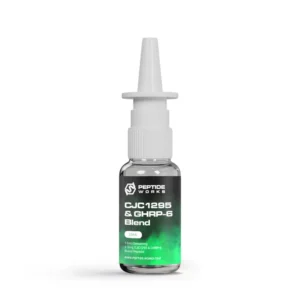
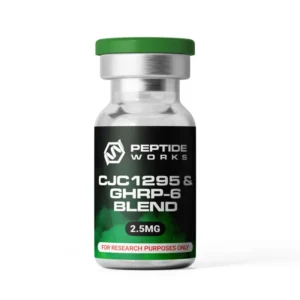
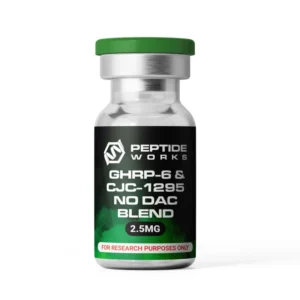
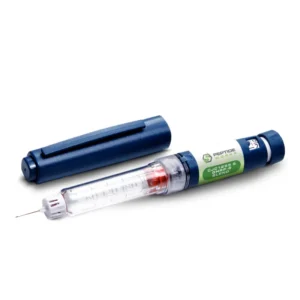

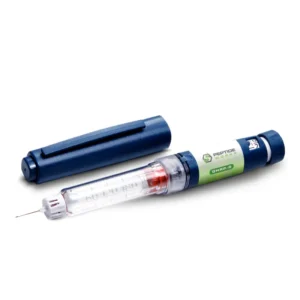
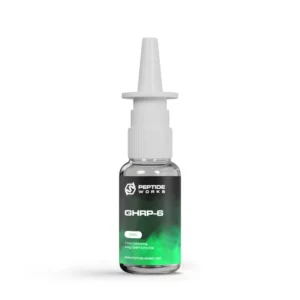
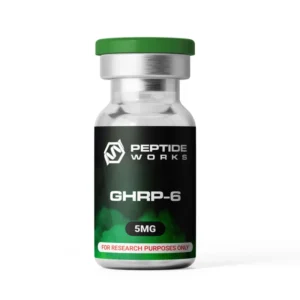
GHRP-6, or Growth Hormone-Releasing Peptide 6, is a synthetic peptide that belongs to the growth hormone secretagogue family that stimulates the release of growth hormone (GH) in the body. Structurally, GHRP-6 is a hexapeptide, meaning it consists of six amino acids linked in a specific sequence.
It is commonly studied in the fields of endocrinology and biochemistry for its potential applications in growth hormone-related research, including its effects on metabolism, muscle growth, and recovery. Researchers often explore its role in understanding growth hormone regulation and its broader implications in medical and scientific studies.
Peptide Sequence (IUPAC Condensed): H-His-D-Trp-Ala-Trp-D-Phe-Lys-NH2
Molecular Formula: C46H56N12O6
Molecular Weight: 873.0 g/mol
Synonyms: Hexapeptide-2
View the GHRP-6 COA
View the GHRP-6 HPLC
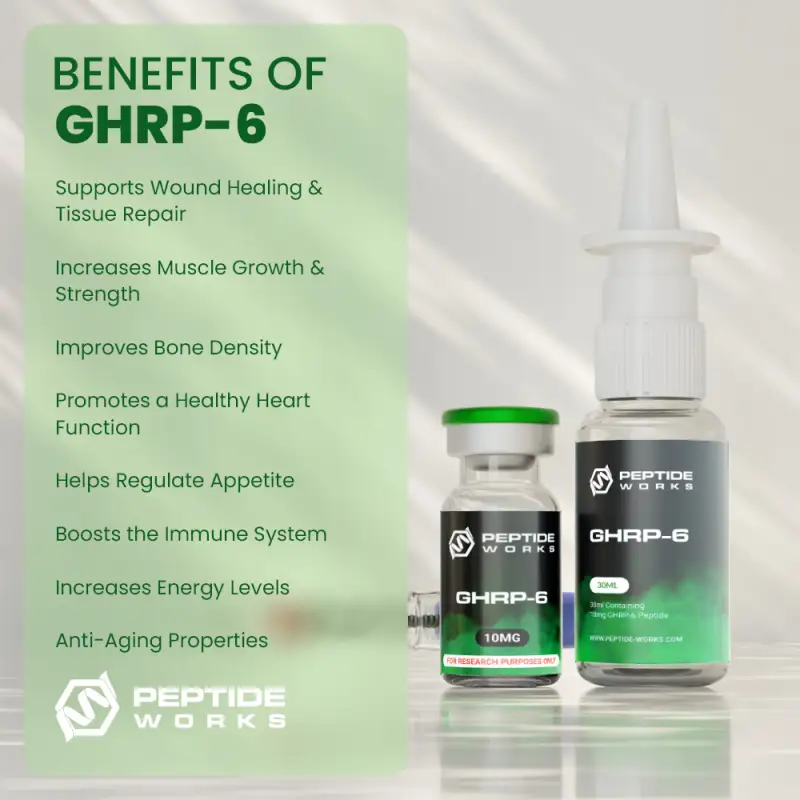
GHRP-6 works by stimulating the release of growth hormone (GH) from the pituitary gland. It works by binding to the ghrelin receptor, also known as the growth hormone secretagogue receptor (GHS-R), located in the hypothalamus and pituitary gland. This interaction replicates the function of ghrelin, a naturally occurring hormone responsible for regulating both hunger and the secretion of growth hormone.
When GHRP-6 attaches to its receptor, it starts a process that boosts the release of growth hormone-releasing hormone (GHRH). At the same time, it reduces somatostatin, a hormone that normally stops GH from being released. This combination leads to a notable increase in growth hormone levels.
Researchers are interested in GHRP-6 because it can increase GH secretion in a controlled way. This makes it useful for studying how growth hormone works, as well as metabolism and tissue repair.
Stimulation of Growth Hormone Release:Research has demonstrated that GHRP-6 stimulates growth hormone (GH) release by acting synergistically with Growth Hormone–Releasing Hormone (GHRH). It enhances somatotrope responsiveness to GHRH and promotes pulsatile GH secretion.
Studies have shown that it also stimulates GHRH release from the hypothalamus without affecting somatostatin levels [1]. This dual action makes it a valuable tool for studying GH regulation. Its dose-dependent effects and synergy with GHRH highlight its potential in research on metabolism, muscle repair, and cell regeneration [2].
Muscle Growth and Repair: Research shows that GHRP-6 helps promote muscle growth and repair by boosting the production of GH and IGF-1. This supports muscle cell growth, development, and recovery. Studies also suggest it increases myogenic markers, collagen type I synthesis, and metabolic activity in muscle cells [3].
It also supports sarcopenia research, highlighting IGF-1’s role in maintaining skeletal muscle mass. GHRP-6’s ability to boost IGF-1 makes it a promising therapeutic for muscle wasting, injury recovery, and age-related muscle loss [4].
Metabolic and Fat Regulation: Research on GHRP-6 shows it affects how the body manages metabolism and fat. It works by stimulating growth hormone (GH), which then promotes the breakdown of fat (lipolysis). This leads to a reduction in body fat and better fat processing. Studies show that the peptide enhances fatty acid synthase and glucose transporter-4 expression, supporting glucose utilization and lipid metabolism [5].
While GHRP-6 alone has limited effects on weight gain, it synergizes with insulin to increase fat mass and adipocyte size in diabetic models [6]. These findings highlight its potential role in metabolic research and fat regulation.
Anti-Inflammatory and Tissue-Healing Effects: Studies indicate that GHRP-6 exhibits anti-inflammatory and tissue-healing effects through GH-independent mechanisms, likely via ghrelin receptor pathways. It reduces fibrosis, oxidative stress, and inflammation in models of liver injury and cardiac ischemia-reperfusion [7].
Research also shows that it accelerates gastrointestinal ulcer recovery and wound healing by activating prosurvival pathways like PI-3K/AKT1, enhancing antioxidant defenses, and reducing reactive oxygen species. These cytoprotective properties make GHRP-6 a promising candidate for mitigating organ damage and promoting tissue repair in various conditions [8].
Neuroprotective and Cognitive Research: Studies have demonstrated that GHRP-6 and ghrelin analogs exhibit neuroprotective effects by shielding neurons from oxidative and ischemic damage and enhancing cognitive function in neurodegenerative models. They influence learning, memory, mood, and neuroplasticity through GHSR1a receptor pathways.
Research highlights their potential in conditions like Alzheimer’s, Parkinson’s, and diabetic cognitive impairment (DCI), where ghrelin modulation improved cognitive outcomes. These findings suggest GHRP-6’s therapeutic promise in neuroprotection, cognitive enhancement, and recovery from neurological disorders [9].
Cardiovascular and Immune System Effects: Research has shown that GHRP-6 demonstrates cardioprotective effects by reducing cardiac fibrosis, inflammation, and oxidative stress, as seen in models of dilated cardiomyopathy and doxorubicin-induced toxicity. It preserves left ventricular function, upregulates prosurvival genes like Bcl-2, and enhances antioxidant defenses [10].
Additionally, studies suggest that the peptide shows potential in modulating immune responses and promoting cellular repair under stress conditions, making it a promising candidate for addressing cardiovascular and immune-related challenges in both research and therapeutic applications.
Appetite Stimulation: GHRP-6 boosts appetite by mimicking ghrelin’s action on the hypothalamus through the GHSR, promoting hunger and food intake. Studies show GHSR is essential for ghrelin’s effects, as Ghsr-null mice showed no appetite increase. GHRP-6’s ability to stimulate appetite makes it a useful research tool for studying cachexia, anorexia, and metabolic syndromes, offering insights into hunger regulation and potential treatments for appetite disorders [11].
Buy GHRP-6 Pre-Mixed Peptide Pen from Peptide Works. Each 5mg cartridge is available individually or as part of a complete kit that includes a reusable pen, needle tips, and a carry case, offering a simple and precise method of preparation.
[1] N Pandya, R DeMott-Friberg, C Y. Bowers, A L. Barkan, and C A. Jaffe (1998) Growth Hormone (GH)-Releasing Peptide-6 Requires Endogenous Hypothalamic GH-Releasing Hormone for Maximal GH Stimulation – The Journal of Clinical Endocrinology & Metabolism, Volume 83, Issue 4, 1 April 1998, Pages 1186–1189.
[2] C D McMahon, L T Chapin, R P Radcliff, K J Lookingland, and H A Tucker (2001) GH-releasing peptide-6 overcomes refractoriness of somatotropes to GHRH after feeding – Journal of Endocrinology, 2001 Jul, Volume 170 (Issue 1), Pages 235-41.
[3] C Jin Lim, J Eun Jeon, S Kyoo Jeong, S Jeong Yoon, et al (2015) Growth hormone-releasing peptide-biotin conjugate stimulates myocytes differentiation through insulin-like growth factor-1 and collagen type I – BMB Reports, 2015 Sep, Volume 48 (Issue 9), Pages 501–506.
[4] A Bian, Y Ma, X Zhou, Y Guo, et al (2020) Association between sarcopenia and levels of growth hormone and insulin-like growth factor-1 in the elderly – BMC Musculoskeletal Disorders volume 21, Article number: 214 (2020).
[5] L Zhao and H Jiang (2023) Growth hormone stimulates lipolysis in mice but not in adipose tissue or adipocyte culture – Frontiers in Endocrinol (Lausanne), 2023 Jan 4, Volume 13, Page 1028191.
[6] M Granado, C García-Cáceres, L M Frago, J Argente, and J A Chowen (2010) The positive effects of growth hormone-releasing peptide-6 on weight gain and fat mass accrual depend on the insulin/glucose status – Endocrinology, 2010 May, Volume 151 (Issue 5), Pages 2008-18.
[7] J Berlanga-Acosta, D Cibrian, J Valiente-Mustelier, J Suárez-Alba, et al (2024) Growth hormone releasing peptide-6 (GHRP-6) prevents doxorubicin-induced myocardial and extra-myocardial damages by activating prosurvival mechanisms – Frontiers in Pharmacology, 2024 May 30, Volume 15, Page 1402138.
[8] J Berlanga-Acosta, A Abreu-Cruz, D García-del Barco Herrera, Y Mendoza-Marí, et al (2017) Synthetic Growth Hormone-Releasing Peptides (GHRPs): A Historical Appraisal of the Evidences Supporting Their Cytoprotective Effects – Clinical Medicine Insights Cardiology, 2017 Mar 2, Volume 11, 1179546817694558.
[9] Y Zhang, R Zhang, X Wang, L Shi, et al (2025) Potential role of ghrelin in neuroprotection and cognitive function: implications for diabetic cognitive impairment – PeerJ, 2025 Feb 21, Volume 13, Page e18898.
[10] J Berlanga-Acosta, D Cibrian, J Valiente-Mustelier, J Suárez-Alba, et al (2024) Growth hormone releasing peptide-6 (GHRP-6) prevents doxorubicin-induced myocardial and extra-myocardial damages by activating prosurvival mechanisms – Frontiers in Pharmacology, 2024 May 30, Volume 15, Page 1402138.
[11] Y Sun, P Wang, H Zheng, R G Smith (2004) Ghrelin stimulation of growth hormone release and appetite is mediated through the growth hormone secretagogue receptor – Proceedings of the National Academy of Sciences U S A, 2004 Mar 30, Volume 101 (Issue 13), Pages 4679-84.
The answers to the most frequently asked questions about GHRP-6.

Buy GHRP-6 Peptide Nasal Spray from Peptide Works. Available in 15ml and 30ml glass spray bottles, this non-invasive administration route provides a convenient and effective option for consistent application.
GHRP-6 may influence erectile function by stimulating ghrelin receptors that affect nitric oxide release and hormonal activity. Some animal studies suggest it can trigger penile erection through central nervous system pathways. However, its overall effect on erectile response remains uncertain and needs more controlled research.
Yes, licensed researchers can legally purchase GHRP-6 in the United States for research and laboratory purposes. The U.S. Food and Drug Administration (FDA) has not approved GHRP-6 for medical or therapeutic use, so it must be sold and used strictly for scientific research following regulatory compliance guidelines.
Yes, GHRP-6 is banned in all competitive sports. The World Anti-Doping Agency (WADA) lists it under Section S2: Peptide Hormones, Growth Factors, and Related Substances. Because GHRP-6 stimulates natural growth hormone release, athletes who use it can face disqualification and sanctions if detected during anti-doping tests.
GHRP-6 may cause increased appetite, water retention, tiredness, headache, or tingling sensations. Some studies note temporary changes in insulin sensitivity, cortisol, and prolactin levels due to its effect on growth hormone release. Side effects vary with dosage and frequency, so careful monitoring during research use is recommended.
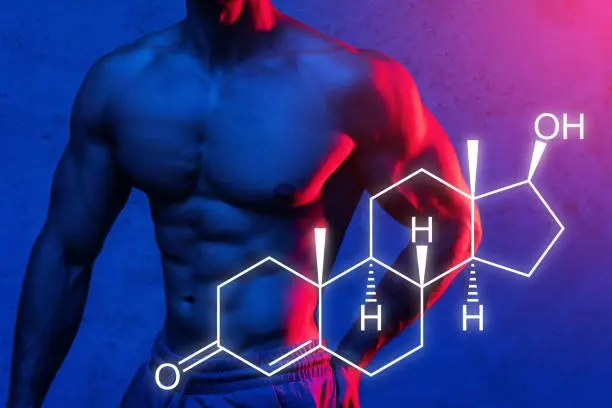
This blog compares GHRP-2 and GHRP-6 peptides, focusing on their research applications. It highlights GHRP-2's superior growth hormone release and reliability versus GHRP-6's stronger appetite stimulation. Researchers can explore their distinct effects on IGF-1 levels, metabolic conditions, and experimental outcomes, helping to determine the best peptide for specific scientific objectives.

This blog examines whether GHRP-6 can be considered a bulking peptide, focusing on its ability to stimulate growth hormone release for muscle growth and recovery. It breaks down the key aspects of bulking, including protein synthesis, tissue repair, and metabolism, while discussing the potential of peptides like GHRP-6 to support muscle development in controlled settings.

This blog explores how GHRP-2 and GHRP-6 peptides may influence sexual function. It looks at their involvement in growth hormone release, hormonal pathways, and downstream effects such as IGF-1 elevation, prolactin regulation, and nitric oxide production. The article also notes that research findings remain mixed and highlights the need for continued studies to better understand their complex mechanisms.
ALL CONTENT AND PRODUCT INFORMATION AVAILABLE ON THIS WEBSITE IS FOR EDUCATIONAL PURPOSES ONLY.
DISCLAIMER: These products are intended solely as a research chemical only. This classification allows for their use only for research development and laboratory studies. The information available on our Peptide Works website: https://peptide-works.com/ is provided for educational purposes only. These products are not for human or animal use or consumption in any manner. Handling of these products should be limited to suitably qualified professionals. They are not to be classified as a drug, food, cosmetic, or medicinal product and must not be mislabelled or used as such.